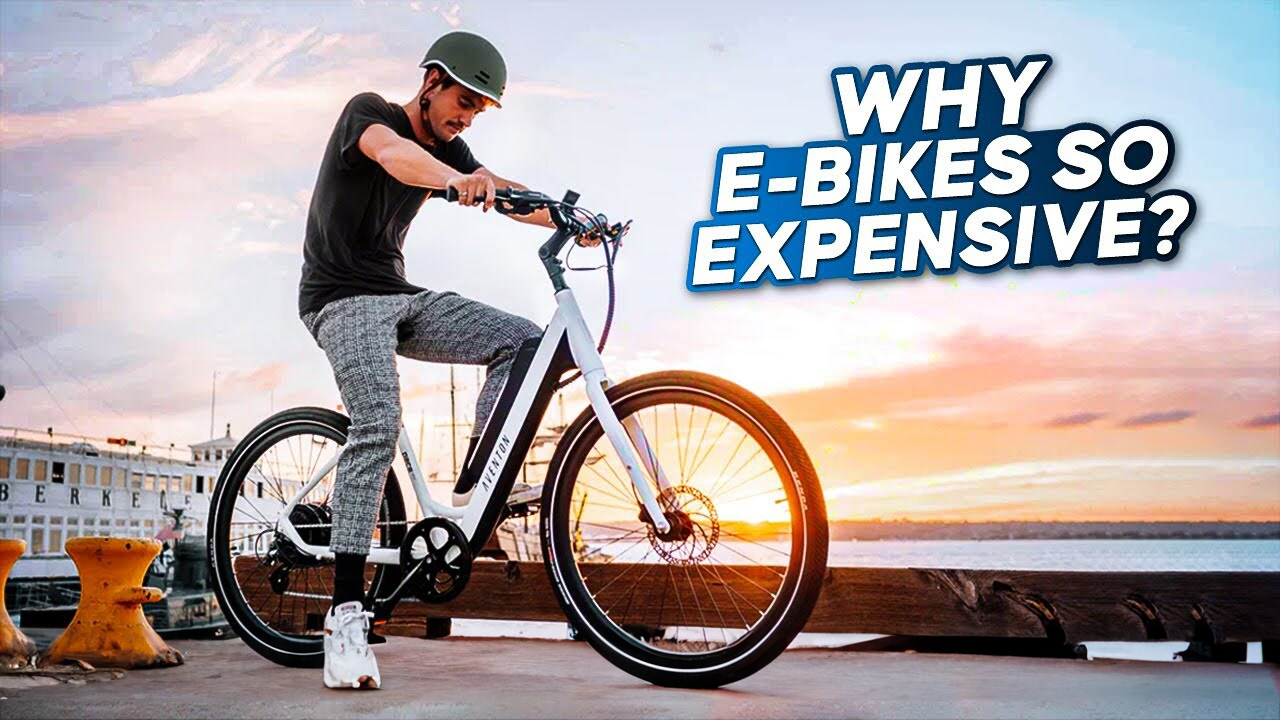Electric bikes have taken the world by storm, and its for good reason. People are quickly discovering how these modern two-wheelers are not only a breeze to ride but also carry a range of eco-friendly advantages over their traditional counterparts. If you’ve been contemplating joining the e-bike movement, you might have noticed that they often come with a hefty price tag, which can be quite shocking, especially for the average-income individual. The truth is, e-bikes can range in price from around $1,000 for basic models to an eye-watering $15,000 for the most luxurious options. The cost varies widely depending on your specific needs and desires. Despite their high price, e-bike sales are skyrocketing, and the industry is experiencing rapid growth. According to Fortune Business Insights, the global electric bike market was valued at a staggering $37.47 billion in 2022!

So, what’s the deal? Why do e-bikes come with a seemingly steep price tag? Are they worth the investment? Let’s dive into these questions and explore the world of electric bikes.
Why Consider an E-bike?
Before discussing the key points, we should talk about why you would consider e-bikes over other electric vehicles or transportation options. E-bikes offer several compelling advantages.
The first benefit of e-bikes is that they are the most environmentally friendly mode of transportation. They produce zero emissions, helping reduce air pollution and combat climate change. In comparison, electric cars still require electricity generated from various sources, some of which may be less green. Riding an e-bike provides low-impact exercise. It’s an excellent way to stay active, improve cardiovascular health, and reduce stress!
One of the best perks of having an e-bike is avoiding traffic congestion. Bikes allow you to navigate through gridlocked traffic more efficiently than cars by taking shortcuts and less crowded routes.
There are additional advantages too, like ease of parking, low maintenance costs, reduced noise emission, and more. You’ll find many reasons to opt for an e-bike for your daily commute!

Why Expensive?
Bicycles are usually not inexpensive, and when you throw in a motor and battery, the price can get much higher. In this section, we are going to discuss crucial reasons behind why e-bikes are so expensive.
Battery
When it comes to e-bikes, the battery is arguably the most critical and expensive component, accounting for a substantial 30 to 40 percent of the overall price. E-bike enthusiasts often face a wide price range when it comes to batteries, from budget-friendly options priced at a few hundred dollars to top-of-the-line choices that can exceed a thousand dollars. While it might be tempting to cut costs by choosing a cheaper battery, it’s essential to remember that this component plays a pivotal role in your overall e-bike experience.

Your e-bike’s battery is a key determinant in how far you can ride and how long your e-bike will last. But why are e-bike batteries so costly? The answer lies in the sophisticated technology that powers them. E-bike batteries are primarily constructed using high-quality lithium-ion cells, with an average lifespan of 2 to 4 years, contingent on usage and maintenance. The cost is significantly influenced by the fact that lithium, a crucial component in these batteries, is a relatively scarce resource on our planet.
Furthermore, lithium-ion battery packs aren’t available in a standardized size, which poses a significant challenge for manufacturers. Designing and assembling these intricate power sources require a specialized approach, which naturally adds to the overall expense. E-bike batteries are built to withstand the elements, made from durable materials that can brave all types of weather conditions. They work in tandem with the electric motor to ensure efficient performance, making your e-bike experience as smooth and enjoyable as possible.
These batteries are not only high-performing but also designed in a compact form, contributing to the minimalist appearance of the e-bike while delivering the necessary power for your ride. This engineering excellence and durability come at a price, but they are investments that will ensure a long and enjoyable life for your e-bike.
The next time you consider the cost of an e-bike battery, remember that it’s a high-quality, durable, and essential component that enhances your overall riding experience. While it might seem expensive at first, its contribution to your e-bike’s performance, longevity, and aesthetics make it worth every penny.
Motor
Motors are engineering marvels, and even basic models can cost a few hundred dollars. The price varies significantly depending on motor quality and type.
Hub motors are a popular, more budget option. Mid-drive motors tend to be high-end, with strengths like efficiency and smooth riding.

So why the high motor costs? With traditional bikes, you supply the power. But e-bikes rely on motors for an added boost. That means extra expenses. These aren’t off-the-shelf items – they’re specially crafted and fitted, increasing labor and parts costs.
Plus, consider electrical engineering, testing, programming, warranties, and customer service. For some companies, these are substantial expenses. When you add everything up, you get a noticeably higher price compared to a regular bicycle!
Quality Components
When it comes to e-bikes, it’s no secret that batteries and motors play a significant role in driving up the overall cost. However, they are not the sole contributors to the elevated price tag. Components such as the drivetrain, wheels, frame material, and brakes all play a part in adding to the total cost. Whether you’re looking at established industry giants or innovative startups, e-bike manufacturers universally opt for high-quality materials and components. But why is this the case?
E-bikes are designed to go faster and cover longer distances than regular bicycles, making the durability of their components paramount. These top-notch components need to withstand the rigors of speed and rough terrain without breaking a sweat. This dedication to quality naturally increases the production costs, ultimately translating to a higher price for the consumer.
It’s important to note that not all affordable components are necessarily of poor quality, but they may not always offer the best value in the long run. While opting for an e-bike with budget components may save you money upfront, you could end up spending more over time. Cheaper parts tend to be less durable and may lack warranties or reliable customer service. Thus, finding the right balance between cost and quality is key.

Niche Market
Even though e-bike sales are steadily increasing, they’re still considered a niche market, and this niche status has a significant impact on their cost. Traditional bicycle manufacturers can produce bikes in large quantities because they know there’s a high demand for them. This helps them keep the prices reasonable. However, e-bike sellers and manufacturers don’t have the same luxury yet. They’re still dealing with lower demand, so they have to order and make fewer e-bikes. So ultimately, when you make fewer of something, it costs more to produce each one!
It means that, until e-bikes become more popular and there’s a bigger demand, manufacturers can’t take advantage of economies of scale to reduce costs. That’s why e-bike prices tend to stay on the high side for now!
Extra Features
E-bikes often come with a heftier price tag, and part of the reason is the integration of advanced features. While buying e-bikes, you’re not just getting a mode of transportation; you’re getting a smart and sophisticated ride. Features like fingerprint sensors, anti-theft systems, onboard bike computers, and seamless smart app connectivity elevate the e-bike experience – but they also come at a cost.
In addition to these high-tech innovations, e-bikes come equipped with a range of standard features such as bright headlights, turn signals, and rear lights. These elements, while seemingly commonplace, are all part of the package designed to enhance your overall riding experience.
These cool extras aren’t just tacked on; they involve special parts, clever design, and superior customer support. They may contribute to a higher price, but they also deliver a safer, more convenient, and incredibly enjoyable ride. The initial investment may seem significant, but the value and experience they add to your e-bike journey make it undoubtedly worthwhile!

The Future of E-Bike Prices: Will They Go Down?
As e-bikes become more popular and their usefulness becomes evident to a growing number of people, the chances of prices dropping look promising. When demand surges, it often sparks increased competition among manufacturers, ultimately leading to lower prices. It’s a concept similar to when a new gadget hits the market – it’s initially pricey, but as demand rises, prices tend to come down.
The exciting news is that as e-bike technology continues to advance and becomes more widespread, the overall cost is expected to decline. Some countries are even offering tax incentives to make e-bikes more affordable. For instance, in the U.S., there’s a proposed tax credit that could potentially cover up to 30% of the cost of a new e-bike.
However, it’s not all smooth sailing just yet. Currently, due to high demand and a shortage of parts, e-bike prices are holding steady or, in some cases, even rising. But this situation is likely temporary. As technology improves and becomes more accessible, e-bike costs should start to trend downward.
So, while e-bikes might still seem a bit pricey at the moment, the future looks bright. They offer savings on gas and maintenance, and with more cities creating bike-friendly infrastructure, they’re becoming an even more appealing option for many. If an e-bike fits your budget and aligns with your cycling goals, it could be a wise and eco-friendly choice for you!










Leave a Comment